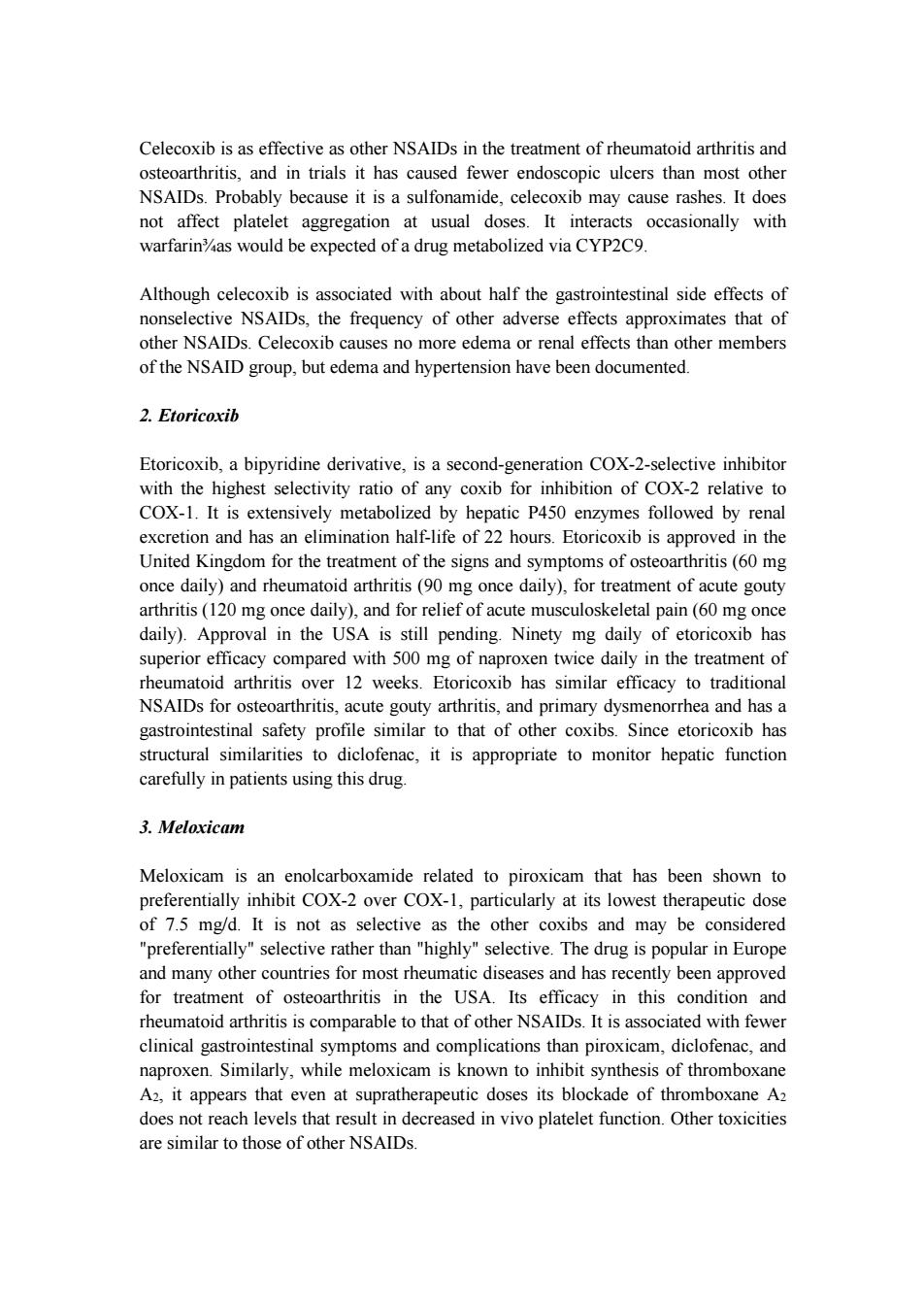正在加载图片...

Celecoxib is as effective as other NSAIDs in the treatment of rheumatoid arthritis and osteoarthritis,and in trials it has caused fewer endoscopic ulcers than most other NSAIDs.Probably because it is a sulfonamide,celecoxib may cause rashes.It does not affect platelet aggregation at usual doses.It interacts occasionally with warfarin%as would be expected of a drug metabolized via CYP2C9. Although celecoxib is associated with about half the gastrointestinal side effects of nonselective NSAIDs,the frequency of other adverse effects approximates that of other NSAIDs.Celecoxib causes no more edema or renal effects than other members of the NSAID group,but edema and hypertension have been documented. 2.Etoricoxib Etoricoxib,a bipyridine derivative,is a second-generation COX-2-selective inhibitor with the highest selectivity ratio of any coxib for inhibition of COX-2 relative to COX-1.It is extensively metabolized by hepatic P450 enzymes followed by renal excretion and has an elimination half-life of 22 hours.Etoricoxib is approved in the United Kingdom for the treatment of the signs and symptoms of osteoarthritis(60 mg once daily)and rheumatoid arthritis(90 mg once daily),for treatment of acute gouty arthritis (120 mg once daily),and for relief of acute musculoskeletal pain(60 mg once daily).Approval in the USA is still pending.Ninety mg daily of etoricoxib has superior efficacy compared with 500 mg of naproxen twice daily in the treatment of rheumatoid arthritis over 12 weeks.Etoricoxib has similar efficacy to traditional NSAIDs for osteoarthritis,acute gouty arthritis,and primary dysmenorrhea and has a gastrointestinal safety profile similar to that of other coxibs.Since etoricoxib has structural similarities to diclofenac,it is appropriate to monitor hepatic function carefully in patients using this drug. 3.Meloxicam Meloxicam is an enolcarboxamide related to piroxicam that has been shown to preferentially inhibit COX-2 over COX-1,particularly at its lowest therapeutic dose of 7.5 mg/d.It is not as selective as the other coxibs and may be considered "preferentially"selective rather than "highly"selective.The drug is popular in Europe and many other countries for most rheumatic diseases and has recently been approved for treatment of osteoarthritis in the USA.Its efficacy in this condition and rheumatoid arthritis is comparable to that of other NSAIDs.It is associated with fewer clinical gastrointestinal symptoms and complications than piroxicam,diclofenac,and naproxen.Similarly,while meloxicam is known to inhibit synthesis of thromboxane A2,it appears that even at supratherapeutic doses its blockade of thromboxane A2 does not reach levels that result in decreased in vivo platelet function.Other toxicities are similar to those of other NSAIDs.Celecoxib is as effective as other NSAIDs in the treatment of rheumatoid arthritis and osteoarthritis, and in trials it has caused fewer endoscopic ulcers than most other NSAIDs. Probably because it is a sulfonamide, celecoxib may cause rashes. It does not affect platelet aggregation at usual doses. It interacts occasionally with warfarin¾as would be expected of a drug metabolized via CYP2C9. Although celecoxib is associated with about half the gastrointestinal side effects of nonselective NSAIDs, the frequency of other adverse effects approximates that of other NSAIDs. Celecoxib causes no more edema or renal effects than other members of the NSAID group, but edema and hypertension have been documented. 2. Etoricoxib Etoricoxib, a bipyridine derivative, is a second-generation COX-2-selective inhibitor with the highest selectivity ratio of any coxib for inhibition of COX-2 relative to COX-1. It is extensively metabolized by hepatic P450 enzymes followed by renal excretion and has an elimination half-life of 22 hours. Etoricoxib is approved in the United Kingdom for the treatment of the signs and symptoms of osteoarthritis (60 mg once daily) and rheumatoid arthritis (90 mg once daily), for treatment of acute gouty arthritis (120 mg once daily), and for relief of acute musculoskeletal pain (60 mg once daily). Approval in the USA is still pending. Ninety mg daily of etoricoxib has superior efficacy compared with 500 mg of naproxen twice daily in the treatment of rheumatoid arthritis over 12 weeks. Etoricoxib has similar efficacy to traditional NSAIDs for osteoarthritis, acute gouty arthritis, and primary dysmenorrhea and has a gastrointestinal safety profile similar to that of other coxibs. Since etoricoxib has structural similarities to diclofenac, it is appropriate to monitor hepatic function carefully in patients using this drug. 3. Meloxicam Meloxicam is an enolcarboxamide related to piroxicam that has been shown to preferentially inhibit COX-2 over COX-1, particularly at its lowest therapeutic dose of 7.5 mg/d. It is not as selective as the other coxibs and may be considered "preferentially" selective rather than "highly" selective. The drug is popular in Europe and many other countries for most rheumatic diseases and has recently been approved for treatment of osteoarthritis in the USA. Its efficacy in this condition and rheumatoid arthritis is comparable to that of other NSAIDs. It is associated with fewer clinical gastrointestinal symptoms and complications than piroxicam, diclofenac, and naproxen. Similarly, while meloxicam is known to inhibit synthesis of thromboxane A2, it appears that even at supratherapeutic doses its blockade of thromboxane A2 does not reach levels that result in decreased in vivo platelet function. Other toxicities are similar to those of other NSAIDs